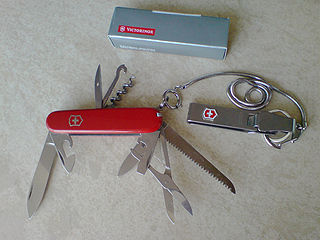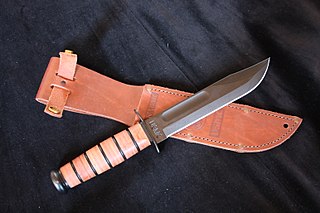
A knife is a tool or weapon with a cutting edge or blade, usually attached to a handle or hilt. One of the earliest tools used by humanity, knives appeared at least 2.5 million years ago, as evidenced by the Oldowan tools. Originally made of wood, bone, and stone, over the centuries, in step with improvements in both metallurgy and manufacturing, knife blades have been made from copper, bronze, iron, steel, ceramic, and titanium. Most modern knives have either fixed or folding blades; blade patterns and styles vary by maker and country of origin.

The Swiss Army knife (SAK) is a pocketknife, generally multi-tooled, now manufactured by Victorinox. The term "Swiss Army knife" was coined by American soldiers after World War II after they had trouble pronouncing the German word "Offiziersmesser", meaning "officer’s knife".

A Japanese kitchen knife is a type of kitchen knife used for food preparation. These knives come in many different varieties and are often made using traditional Japanese blacksmithing techniques. They can be made from stainless steel, or hagane, which is the same kind of steel used to make Japanese swords. Most knives are referred to as hōchō or the variation -bōchō in compound words but can have other names including -kiri. There are four general categories used to distinguish the Japanese knife designs: handle, blade grind, steel, and construction.

A kitchen knife is any knife that is intended to be used in food preparation. While much of this work can be accomplished with a few general-purpose knives – notably a large chef's knife, a tough cleaver, a small paring knife and some sort of serrated blade – there are also many specialized knives that are designed for specific tasks. Kitchen knives can be made from several different materials.
In cooking, a chef's knife, also known as a cook's knife, is a cutting tool used in food preparation. The chef's knife was originally designed primarily to slice and disjoint large cuts of beef. Today it is the primary general-utility knife for most Western cooks.

The Santoku bōchō or Bunka bōchō (文化包丁) is a general-purpose kitchen knife originating in Japan. Its blade is typically between 13 and 20 cm long, and has a flat edge and a sheepsfoot blade that curves down an angle approaching 60 degrees at the point. The term Santoku may refer to the wide variety of ingredients that the knife can handle: meat, fish and vegetables, or to the tasks it can perform: slicing, chopping and dicing, either interpretation indicating a multi-use, general-purpose kitchen knife. The Santoku's blade and handle are designed to work in harmony by matching the blade's width and weight to the weight of the tang and the handle.
WÜSTHOF is a knife-maker based in Solingen, Germany. Family owned for seven generations, the company's main products are mid-priced to high-end kitchen knives for domestic and professional use. WÜSTHOF is one of the leading manufacturers of chef's knives.
Spyderco is an American cutlery company based in Golden, Colorado, producing knives and knife sharpeners. Spyderco pioneered many features that are now common in folding knives, including the pocket clip, serrations, and the opening hole. Spyderco has collaborated with 30 custom knife makers, athletes, and self-defense instructors for designs and innovated the usage of 20 different blade materials.

Sharpening is the process of creating or refining the edge joining two non-coplanar faces into a converging apex, thereby creating an edge of appropriate shape on a tool or implement designed for cutting. Sharpening is done by removing material on an implement with an abrasive substance harder than the material of the implement, followed sometimes by processes to polish/hone the sharp surface to increase smoothness.

A ceramic knife is a knife with a ceramic blade typically made from zirconium dioxide (ZrO2; also known as zirconia), rather than the steel used for most knives. Ceramic knife blades are usually produced through the dry-pressing and firing of powdered zirconia using solid-state sintering. The blades typically score 8.5 on the Mohs scale of mineral hardness, compared to 4.5 for normal steel and 7.5 to 8 for hardened steel and 10 for diamond. The resultant blade has a hard edge that stays sharp for much longer than conventional steel blades. However, the blade is brittle, subject to chipping, and will break rather than flex if twisted. The ceramic blade is sharpened by grinding the edges with a diamond-dust-coated grinding wheel.
Sabatier is the maker's mark used by several kitchen knife manufacturers—by itself it is not a registered brand name. The name Sabatier is considered to imply a high-quality knife produced by one of a number of manufacturers in the Thiers region of France using a full forging process; the knives of some of these manufacturers are highly regarded. However, the name "Sabatier" came into use before intellectual property laws and is not protected; knives legally bearing the name range from high-quality knives made in France to cheap mass-produced products of poor quality from France and other countries; a registered logo or full name, or both, such as "65 Sabatier Perrier", is necessary to establish origin and quality.

A cleaver is a large knife that varies in its shape but usually resembles a rectangular-bladed hatchet. It is largely used as a kitchen or butcher knife and is mostly intended for splitting up large pieces of soft bones and slashing through thick pieces of meat. The knife's broad side can also be used for crushing in food preparation and can also be used to scoop up chopped items.
Kershaw Knives designs, sources and manufactures a wide range of knives, including pocketknives, sporting knives, and kitchen cutlery. Kershaw is a brand of Kai USA Ltd., a member of the KAI Group, headquartered in Tualatin, Oregon, United States.

W.R. Case & Sons Cutlery Company is an American manufacturer of traditional pocket knives, fixed blades/sporting knives, kitchen knives, limited edition commemoratives and collectibles. The company originated in Little Valley, New York, around the turn of the 20th century, before relocating to its current home, Bradford, Pennsylvania, in 1905. The company's namesake, William Russell Case, first made knives with his brothers under the name Case Brothers Cutlery Company. His son, John Russell ("Russ") Case, worked as a salesman for his father's company before founding W.R. Case & Sons.
Honyaki (本焼) is the name for the Japanese traditional method of metalwork construction most often seen in kitchen knives by forging a blade, with a technique most similar to the tradition of nihonto, from a single piece of high-carbon steel covered with clay to yield upon quench a soft, resilient spine, a hamon, and a hard, sharp edge. Honyaki as a term alone can refer to either mizu honyaki (water-quench) or abura honyaki. The goal is to produce a sharper, longer lasting edge than is usually achievable with the lamination method. The term has been adapted to describe high-end mono-stainless in Japan and carbon blades by non-Japanese bladesmiths that have a hamon but are made with Western steel, heat treat, equipment, finishing, and design.
Friedr. DICK is a German cutlery manufacturer founded 1778 in Esslingen, Germany. Known by their logo name of F. Dick, the company has three lines of business. F. Dick specializes primarily in butcher's knives and tools, where it is regarded as a market leader in both Europe and North America. The company is known for its wide range of high quality sharpening steels and is also renowned for its chef's knives where it is a respected manufacturer in the professional sector, but less established for the casual user. Although F. Dick cutlery is available for purchase in the American market, the brand has not caught-on with mainstream American consumers. As a result, the brand is limited in its availability, and is generally only available at cutlery specialty-stores in the American market.

Ka-Bar is the contemporary popular name for the combat knife first adopted by the United States Marine Corps in November 1942 as the 1219C2 combat knife, and subsequently adopted by the United States Navy as the U.S. Navy utility knife, Mark 2. Ka-Bar is the name of a related knife manufacturing company, Ka-Bar Knives., Inc., of Olean, New York, a subsidiary of the Cutco Corporation.

A steak knife is a sharp table knife designed to efficiently and effectively cut steak. This type of knife comes in a variety of styles and sizes; however, the design often used in a steakhouse typically features a partially serrated blade and wood handle.

Chroma Cutlery(also known as Chroma Cnife, and styled CHROMA) is a kitchen knife-maker based in Demorest, Georgia, US, founded in 1989. Chroma also produces spice grinders, knife sharpening stones, kitchen shears and other cooking accessories. The company also manufactures products for other brands.
















